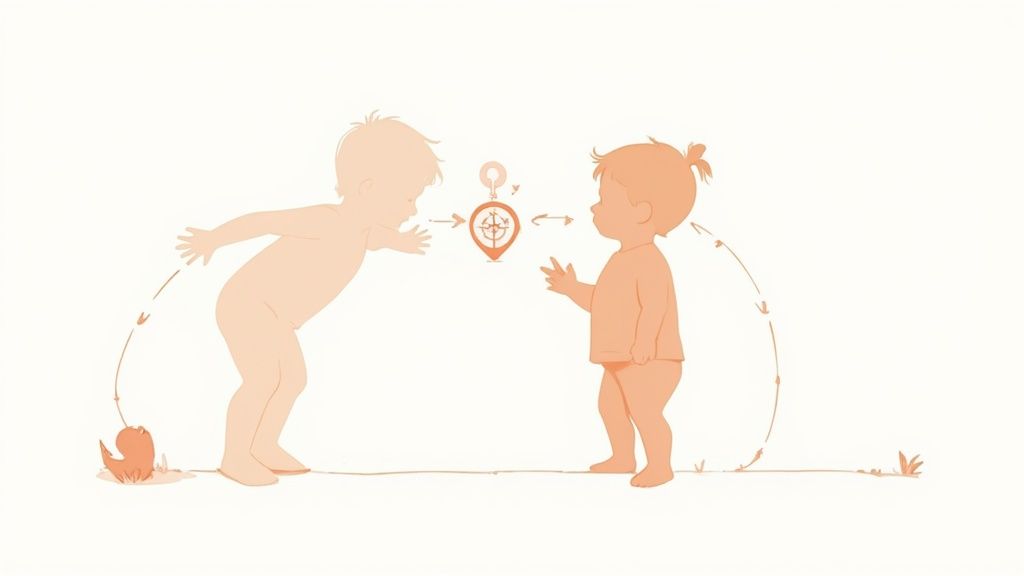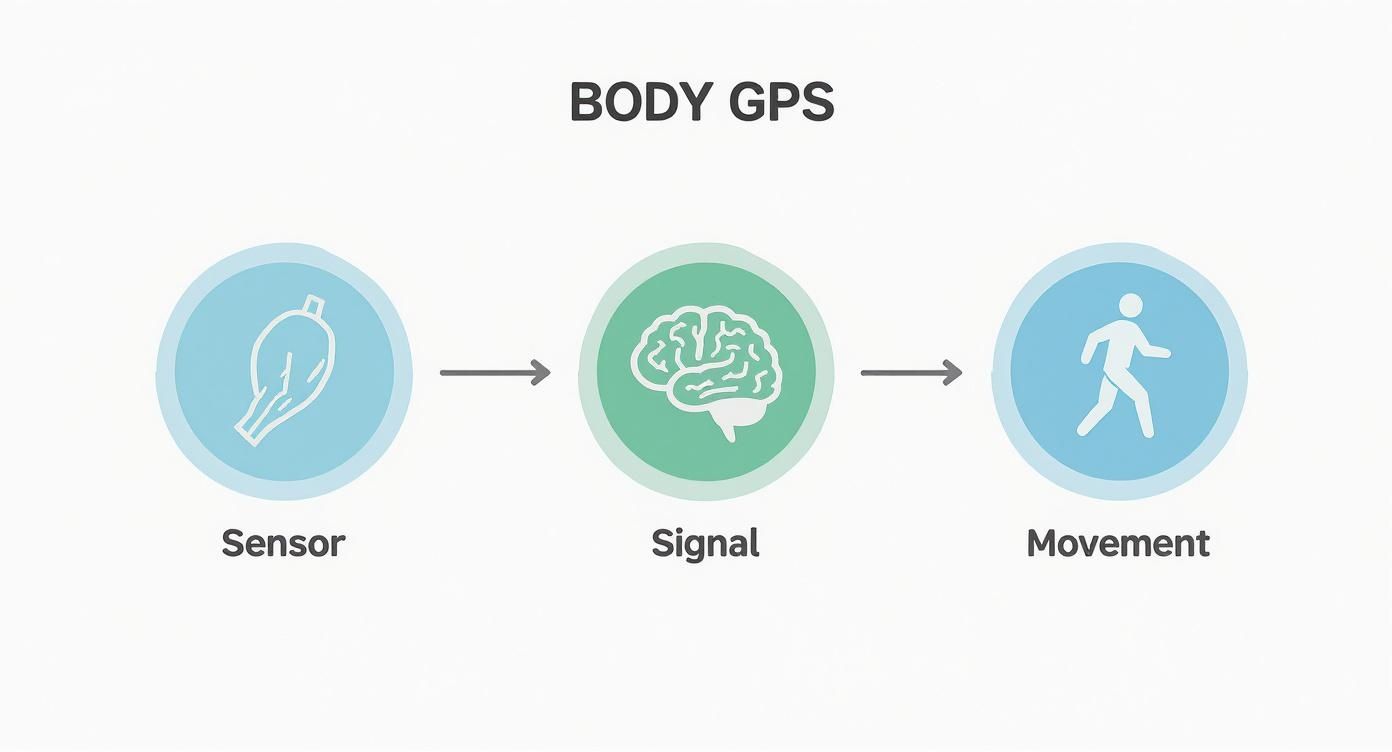What Is Proprioceptive Input A Guide for Parents
November 13, 2025

Ever heard of a "sixth sense"? While it sounds like something out of a movie, we all have one. It's called proprioceptive input, and it's basically your body's built-in GPS. This is the magic that lets your brain know where your body parts are without you ever having to look. It’s why you can touch your nose with your eyes closed, walk through a dark room without bumping into everything, or sip your coffee while typing.
This sense is the foundation for body awareness, graceful movement, and even emotional balance.
Your Quick Guide to Proprioceptive Input

Think about the last time you walked up a flight of stairs. You probably didn't stare at your feet to guide them to each step, right? You just knew how high to lift your leg and how much muscle to put into it. That intuitive "knowing" is your proprioceptive system in action.
It works through a network of tiny receptors tucked away in your muscles and joints. These receptors are constantly firing off messages to your brain, creating a non-stop feedback loop.
This loop provides a constant stream of information about:
- Body Position: An internal map of where your arms, legs, and head are in space and in relation to each other.
- Movement: A sense of how fast and in what direction your limbs are moving.
- Force and Effort: The ability to judge how much strength you need to pick up an egg versus a gallon of milk.
This quiet, behind-the-scenes communication is what allows us to move through the world with coordination and confidence. It’s the unsung hero behind every physical action, from tying a shoe to catching a ball.
For parents, understanding this is a total game-changer. It helps you connect the dots and figure out why your child might crash into furniture, chew on their shirt collar, or crave tight hugs to feel calm.
Proprioception is more than just movement; it’s about feeling grounded and secure in your own body. This sense helps organize the brain and can have a powerfully calming effect on an overstimulated nervous system.
How Proprioceptive Input Shapes Our World
To get a clearer picture, let's break down the main jobs of this incredible system.
| Component | What It Does | Everyday Example |
|---|---|---|
| Body Awareness | Creates a mental map of your body. | Knowing where your foot is to scratch an itch without looking down. |
| Motor Control | Helps you execute smooth, coordinated movements. | Writing your name with a pen or kicking a soccer ball. |
| Grading Force | Allows you to use the "just right" amount of muscle. | Petting a cat gently instead of with too much pressure. |
| Postural Stability | Keeps you upright and balanced without conscious thought. | Sitting straight in a chair or standing on one foot. |
| Emotional Regulation | Provides calming input to the nervous system. | Feeling grounded and centered after a big, warm hug. |
As you can see, this system is working hard all day long to keep us organized and moving effectively.
When this system has trouble processing information efficiently, it can lead to some real-world challenges. These issues are often part of a bigger picture, which you can learn more about by understanding what is sensory processing disorder.
The good news? You don't need fancy equipment to support the proprioceptive system. The best input often comes from simple, everyday activities that involve deep pressure or "heavy work." For a deeper dive into how this works therapeutically to calm the nervous system, this guide on Deep Pressure Therapy for Anxiety offers some fantastic insights.
Alright, let's ditch the textbook-speak and get into how this incredible "body awareness" sense really works.
How Your Body’s Internal GPS Actually Works
So, how does this amazing internal navigation system pull it off? It all boils down to a constant, super-fast chat between your body and your brain.
Tucked away deep inside every single one of your muscles and joints are specialized nerve endings called mechanoreceptors. You can think of them as tiny, microscopic messengers that make this whole system hum.
Picture these receptors like the motion sensors in a high-tech security system. The moment you move—whether you're stretching out your arm, bending your knee, or making a fist—these little guys spring into action. They detect every subtle change in muscle length, tension, and the angle of your joints.
In a flash, they shoot electrical signals up the spinal cord straight to the brain. This isn't a slow, thoughtful process; it's an unconscious, nonstop river of information. Your brain takes all this data and, without you ever having to think about it, builds a live, three-dimensional map of where your body is in space.
The Feedback Loop in Action
This constant back-and-forth is what we call a feedback loop. The brain gets a signal (like, "Hey, the bicep is contracting!") and immediately shoots a message back to the muscles to fine-tune the movement ("Got it. Fire up the tricep to keep things smooth and controlled"). This happens thousands of times a day, allowing us to move without looking like clumsy robots.
It's this seamless process that makes complex activities feel almost second nature.
- Catching a Ball: Your brain uses proprioceptive information to instantly calculate where your hand is and how fast it needs to move to meet the ball. It's pure physics, but it feels like instinct.
- Navigating a Playground: A kid instinctively knows how high to lift their feet to get up the climbing wall or how to shift their weight to zip down a slide without toppling over.
- Holding a Crayon: This system helps a child apply just the right amount of pressure—not so light that the mark is barely there, and not so hard that the crayon snaps in half.
This sensory system is the bedrock of what you might call physical intelligence. It's what gives a child a feeling of being in command of their own body, which is absolutely critical for learning, playing, and building confidence.
At its core, proprioceptive input is all about the body's ability to understand its own position and movement, all thanks to those signals from the mechanoreceptors. This sense covers everything from limb position and motion to effort and force, all working together to help us interact with the world around us. If you want to dive deeper into the science, you can read the full research about these sensory components.
But this system does more than just manage movement. It also has a huge role in keeping our nervous system balanced. The deep pressure signals you get from "heavy work" activities send calming messages to the brain. That’s why a tight hug or being snug under a heavy blanket can feel so incredibly organizing and soothing. It's one of the most powerful tools we have for self-regulation.
Spotting Proprioceptive Needs in Your Child
So, how can you tell if your child's internal "body GPS" is running smoothly? The best clues almost always come straight from their behavior. Every kid has a unique sensory profile, and the way they act is a powerful form of communication, telling you exactly what their nervous system is craving—or what feels like way too much.
Learning to read these signals is the first big step toward providing the right kind of support. When it comes to proprioception, a child's response usually falls into one of two camps: they're either seeking more of it, or they're avoiding it. Neither one is "bad" or "wrong." It’s simply how their brain is wired to process all that information coming from their muscles and joints.
This simple concept map is a great visual for how proprioceptive input travels from the body's sensors to the brain and then into coordinated movement.

As you can see, when this pathway is working well, movement feels confident and easy. When there's a disconnect, a child might start seeking out or avoiding certain inputs just to feel more in control.
The Proprioceptive Seeker
A child who is a proprioceptive seeker is often affectionately called a "human bulldozer." It’s not that they’re trying to be rough; their nervous system just isn't getting enough information from typical, everyday movements. To feel grounded and organized, they have to actively search for more intense sensations. Think of it like their internal volume for body awareness is turned way down, and they're doing everything they can to crank it up.
You might have a proprioceptive seeker if your child:
- Absolutely loves rough-and-tumble play—we’re talking crashing, wrestling, and jumping on any and all furniture.
- Gives bone-crushing hugs or squeezes your hand way too hard without even realizing it.
- Constantly chews on non-food items like their shirt collar, pencils, or the edges of their toys.
- Stomps their feet when they walk or just seems to move with way more force than necessary.
- Prefers tight clothing or loves to be wrapped up snugly in heavy blankets.
These actions aren't misbehavior. They are a child's genuine attempt to get the deep-pressure feedback their brain is practically begging for. It’s what helps them finally feel where their body is and feel secure in the space around them.
The Proprioceptive Avoider
On the flip side, we have the proprioceptive avoider. For these kids, the signals from their muscles and joints can feel confusing, unreliable, or even uncomfortable. It's like their internal GPS is faulty, so they tend to steer clear of activities that challenge their body awareness or might lead to unexpected movements.
A child who avoids proprioceptive input might:
- Appear clumsy or uncoordinated, frequently bumping into furniture or tripping over their own feet.
- Really struggle with motor tasks that require precision, like buttoning a shirt or using a fork and knife.
- Strongly dislike rough play, big hugs, or the unpredictable jostling of crowded spaces.
- Move with a certain stiffness or hesitation, as if they're constantly unsure of where their body is.
- Have a tough time grading force—for example, pressing down so hard with a crayon that it breaks, or so softly you can barely see the mark.
Understanding your child's unique sensory profile is like getting a user manual for their nervous system. By observing whether they seek out or avoid certain inputs, you can start responding to their needs proactively instead of just reacting to their behavior.
To make it even clearer, here’s a quick side-by-side look at some of these common behaviors.
Proprioceptive Seeking vs Proprioceptive Avoiding Behaviors
This table breaks down some of the key differences you might see in a child's daily actions.
| Behavior Category | Signs of a Proprioceptive Seeker | Signs of a Proprioceptive Avoider |
|---|---|---|
| Physical Contact | Gives tight, forceful hugs; enjoys wrestling. | Dislikes hugs; avoids physical games. |
| Movement Style | Stomps feet; crashes into furniture; loves to jump. | Moves cautiously; appears clumsy or uncoordinated. |
| Oral Motor | Chews on shirt collars, toys, or fingernails. | May be a picky eater, avoiding certain textures. |
| Task Engagement | Prefers activities with heavy lifting or pushing. | Struggles with fine motor skills like writing. |
Becoming a skilled observer of these patterns is one of the most powerful things you can do as a parent or educator. It helps you reframe what looks like defiance or a "behavior problem" into what it truly is: a child’s best attempt to regulate themselves and make sense of the world around them.
Everyday Propioceptive Activities for Home and School

Here’s the good news: you don't need a fancy therapy gym or a room full of expensive equipment to support your child’s proprioceptive system. The most powerful strategies are the simple, everyday tasks you can weave right into your family's daily rhythm. This is where you can turn ordinary moments into powerful sensory support.
The two magic phrases to remember are heavy work and deep pressure. Think of activities that involve pushing, pulling, lifting, or squeezing. This is the kind of intense feedback that helps a child’s nervous system feel organized, grounded, and calm. The trick is to make these activities a natural part of the day, not just another item on a never-ending to-do list.
By sprinkling these organizing tasks throughout the day, you’re giving your child’s body the grounding input it craves, which can lead to better focus and fewer challenging behaviors. It’s all about being a little more intentional with the things you’re probably already doing.
Easy Proprioceptive Ideas for Home
Your home is an absolute playground of proprioceptive opportunities. So many daily chores and playful moments are already packed with the heavy work that sensory-seeking kids need to feel regulated and in control.
Here are a few simple ideas to get you started:
- Kitchen Helper: Let them be your little sous chef! Carrying in grocery bags, stirring thick cookie dough, kneading bread, or putting away heavy cans gives their muscles great feedback.
- Cleaning Crew: Pushing the vacuum, mopping the floor, scrubbing the tub, or wiping down tables are all fantastic ways to provide resistance and deep input.
- Yard Work: Get them outside to help with raking leaves, digging in the garden, pulling weeds, or pushing a kid-sized wheelbarrow filled with dirt.
- Laundry Duty: Carrying a full laundry basket (or even just pushing it across the floor) and transferring wet, heavy clothes to the dryer are perfect heavy-work tasks.
And don't forget playtime! Building a fort with heavy couch cushions, having a gentle pillow fight, or rolling your child up tightly in a heavy blanket to be a "human burrito" are all wonderful ways to provide that calming deep-pressure input.
Simple Proprioceptive Strategies for the Classroom
The classroom can be a tough environment for a child with proprioceptive needs, but small, thoughtful adjustments can make a world of difference. The key is to offer movement breaks and tasks that fit naturally into the classroom flow without being disruptive.
Teachers can easily bake these strategies into the school day:
- Classroom Jobs: Make the child the official "door holder," "book collector," or the person who stacks chairs at the end of the day. These jobs have a real purpose and provide great input.
- Errand Runner: Ask them to carry a stack of books to the library or deliver a box of supplies to another classroom.
- Seating Solutions: Loop a resistance band around the front legs of their chair so they can push against it with their feet while they work.
- Movement Breaks: Lead the whole class in quick breaks for wall push-ups, jumping jacks, or a few yoga poses.
These small activities give a child a chance to reset their nervous system, providing that focused proprioceptive input they need to return to their desk ready to learn.
Key Takeaway: The goal is to integrate, not isolate. By making heavy work a part of chores and play, you give your child a consistent and predictable way to get the sensory input they need to feel calm and organized throughout their day.
It's also important to remember that creativity is your best friend in keeping kids engaged. For instance, you can combine a quiet activity like coloring with proprioceptive input. Have them color while lying on their tummy (propped up on their elbows) or tape the paper to a wall so they have to work against gravity to color. You can explore a whole range of sensory integration activities in our detailed guide.
For younger kids, you can find tons of engaging sensory play ideas for toddlers that are perfect for getting started. The more you look, the more you’ll start to see opportunities for sensory support hiding in plain sight.
Of course. Here is the rewritten section, crafted to sound like it was written by an experienced human expert, following all the provided style guidelines and requirements.
Knowing When to Talk to a Professional
The everyday strategies we've talked about are fantastic tools for your sensory toolkit. But sometimes, despite all your best efforts, it can feel like you’ve hit a wall. If sensory challenges are consistently getting in the way of daily life, it might be time to bring in an expert.
Reaching out for professional help isn't a sign that you've done something wrong. Far from it. Think of it as a powerful, proactive step toward getting your child the precise, individualized support they need to really shine.
Clear Signs It’s Time for an Evaluation
So, how do you know when it's time to make that call? Certain patterns can suggest a child's sensory processing difficulties are a bit more than simple home-based activities can manage. These red flags often point to a need for a more structured, therapeutic game plan.
Consider seeking an evaluation if your child's sensory needs:
- Consistently disrupt school: This could look like an inability to sit still and focus in class, frequent emotional meltdowns over seemingly small things, or real trouble participating in group activities and lessons.
- Significantly impact family life: Are daily routines like mealtimes, getting dressed, or bedtime becoming constant battles? If it’s causing stress for the whole family, that’s a big sign.
- Interfere with friendships: Your child might avoid playgrounds altogether, struggle to play appropriately with peers without getting too rough, or just seem completely overwhelmed in social settings.
- Lead to safety concerns: A child who isn't quite sure where their body is in space might take physical risks without realizing the danger, like climbing too high or jumping from unsafe surfaces.
If these scenarios feel a little too familiar, an Occupational Therapist (OT) is your best next step. OTs are the experts in all things sensory processing and can provide a thorough, compassionate assessment. To get a better feel for what they do, you can explore our guide on what is occupational therapy for children.
What an OT Evaluation Looks Like
The word "evaluation" can sound a little intimidating, but it’s really a collaborative and often playful process. An OT will use a mix of standardized assessments, skilled observation of your child at play, and great conversations with you to build a complete picture of your child’s unique sensory profile. They’ll look at motor skills, body awareness, and how your child responds to all kinds of different sensory inputs.
An OT’s goal is never to "fix" your child. It’s to give them the tools to navigate their world more confidently and comfortably. They work to understand your child's unique nervous system and build on their amazing strengths.
After the assessment, the OT will put together a customized plan. This often includes something called a "sensory diet"—a carefully designed menu of proprioceptive activities tailored to your child’s specific needs. This plan provides the "just right" amount of input throughout the day to help keep their nervous system calm and organized, giving you a clear, practical roadmap for success.
Got Questions About Proprioceptive Input? We've Got Answers.
Even once you get the hang of what proprioceptive input is, a few questions always seem to pop up. It's one thing to understand the science, but it's another to put it into practice in your own home or classroom.
Let's dig into some of the most common questions that parents, teachers, and caregivers have. Getting these nuances right can make all the difference, helping you turn that knowledge into real, everyday support.
Is Proprioception the Same as Vestibular or Tactile Senses?
This is a fantastic question because these three are the powerhouse partners of sensory processing, but they each have very distinct jobs. Think of them as a team of specialists who are constantly talking to each other.
- The Tactile System: This is your sense of touch. It’s all about the information coming from your skin—things like pressure, texture, and temperature.
- The Vestibular System: Located deep in your inner ear, this is your body's motion and balance detector. It tells your brain if you’re moving, how fast, and which way you're headed.
- The Proprioceptive System: This is your "body awareness" sense, with information coming from your muscles and joints. It tells your brain where your body parts are and what they're doing without you having to look.
They almost always work together. Picture a kid on a swing set: they feel the wind on their skin (tactile), the sensation of flying through the air (vestibular), and the muscle work of pumping their legs (proprioceptive). Each one provides a unique piece of the sensory puzzle.
Can Quiet Activities Actually Offer Proprioceptive Input?
Absolutely! And this is a brilliant trick for helping a child regulate during seated tasks like homework or coloring, which can feel like torture for a sensory seeker. The key is to add an element of resistance or "heavy work."
You can easily adapt quiet time with a few simple tweaks:
- Change Their Position: Have your child color or do a puzzle while lying on their tummy, propped up on their elbows. This simple change fires up core, back, and shoulder muscles.
- Go Vertical: Tape coloring sheets or worksheets to a wall or an easel. Working against gravity forces them to use more muscle control in their arms and shoulders.
- Use Resistive Materials: Instead of regular crayons, try therapy putty or modeling clay. Have them press small balls of putty onto a coloring page—it provides incredible heavy work for all the little muscles in their hands and fingers.
How Do I Safely Manage Crashing Behavior?
Constant crashing is classic proprioceptive-seeking behavior. A child isn't trying to be destructive; their body is literally screaming for intense, all-over deep pressure just to feel organized and calm. The goal isn't to stop it, but to redirect that powerful need into safe, acceptable outlets.
Your role isn't to stop the crashing but to provide a safer way to do it. Honoring the underlying sensory need is the most effective way to manage the behavior and ensure everyone stays safe.
Try creating a designated "crash zone" with a pile of old pillows, beanbag chairs, or cushions. You can make games out of it, like running and jumping into the crash pad. Or, you could wrap them up tightly in a heavy blanket to be a "human burrito" or even have a supervised pillow fight. This gives them the intense input they're craving while setting clear, safe boundaries.
Will My Child's Sensory Needs Change Over Time?
Yes, a child's proprioceptive needs can and almost always do evolve. As their nervous system matures, their ability to process sensory information often becomes much more efficient. They start to develop better self-regulation skills and may not need the same frequency or intensity of input they did when they were younger.
That said, it's totally normal to see a temporary spike in sensory-seeking behaviors during times of stress, big life changes, growth spurts, or new developmental challenges. The real goal is to equip your child with a lifelong toolkit of strategies they can use to understand and manage their own unique sensory profile, no matter what life throws their way.
At ColorPageAI, we believe creative activities should be adaptable for every child's unique needs. You can instantly create custom coloring pages that are perfect for vertical coloring activities or match any theme your child is obsessed with, turning a simple activity into a powerful sensory tool. Generate up to five free, personalized coloring pages and see the difference it can make.
Ready to start coloring?
Join ColorPage.ai today and get 5 free credits to create your own custom coloring pages!
Start creating